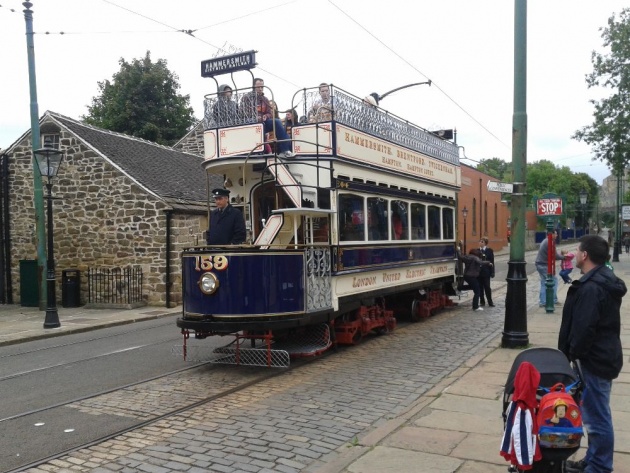
The London United Tramways 1902 tram at Town End
The tram is a form of urban transport that runs on tracks along public streets, or on their own separate right of way. Some tramlines also operate between cities. The majority of trams are powered by electricity, with overhead cables providing the power, as the vehicles lack their own power source.
Trams were, for many years, a popular form of public transport in the United Kingdom, starting with the earliest horse drawn trams in the 19th century and progressing to electric tramways. By the 1930s, Britain had a large, and interconnected, system of tramways spanning the entire country, although even then the tramways had already started their decline. Following the end of the First World War and the rise in the popularity of the motor vehicle, both for private use and for public transport such as buses, trams had commenced their long decline.
In 1962, the last Glasgow Corporation Tramways service ran, leaving only the Blackpool tramway surviving from the first generation built, Blackpool being a resort town. This last tramway has been modernised since. However, by the end of the 20th century, trams started seeing a resurgence, with new systems being built (most of the old network having been dismantled unfortunately), with trams now running in several major cities across the country.
How to Find the Museum
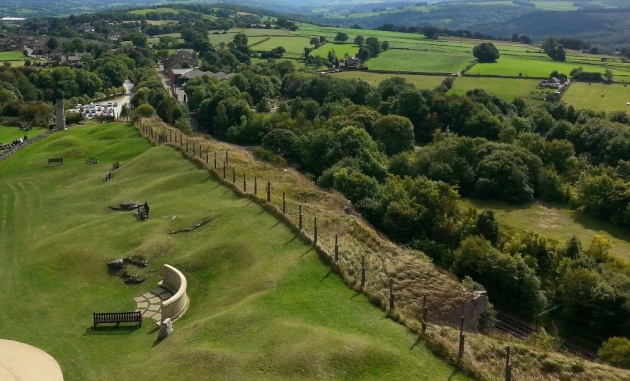
Looking down at Crich Tramway Village from Crich Memorial Stand
Crich Tramway Village is in the small village of Crich in Derbyshire (the address is Crich Tramway Village, Crich, Matlock, Derbyshire, DE4 5DP, United Kingdom and the phone number is UK 01773 854 321). At the site there is a car and coach park; these are generally the easiest methods of getting there. Using public transport, the nearest railway station is in Whatstandwell, a fairly steep uphill walk of a mile away, as well as a bus stop directly outside the entrance.
Once purchased, a ticket will last for an entire year for those who purchase one at the full price (except for World War II/1940s events). There are various discounted tickets available as well group bookings.
The museum itself is located along the edge of the Derwent Valley, which has been named a World Heritage Site by U.N.E.S.C.O.
About the Museum and the Site
The museum is built in a former limestone quarry, Cliff Quarry, in Derbyshire. The quarry was originally bought by George Stephenson to use the limestone from the quarry with coal from the Clay Cross area of Derbyshire to produce burnt lime for agricultural purposes. Stephenson himself was a civil and mechanical engineer born in Northumberland in England. The 'Father of Railways,' amongst his many achievement, he built the first inter-city railway to use steam locomotives and the rail gauge he used is still used today as the standard gauge for most of the world's railways.
The museum is open from spring to late autumn and there are working tramlines going from Town End to Glory Mine. The first electric tram ran at the museum in 1964. The museum itself dates back to 1948 - or rather the organisation that founded it does, as in that year it purchased the first tram for £10 following a farewell tour of Southampton Tramways. The site of the museum was not established until 1959, which was first leased and later purchased
In 1967, the decision was made to construct a streetscape through which the trams would run. The museum has tracks, overhead cables, buildings and street furniture which have come from all over the country, in some cases dismantled brick by brick and then rebuilt at the museum, and there are a number of purpose built buildings as well and one that was already on the site from Stephenson's time.
The Museum Has Several Events Every Year
The museum hosts a number of events throughout the year. These can change from year to year, but there are some standard events that usually run each year, although perhaps with some changes.
In spring there is the World War II/1940s event with trams from the period accompanied by displays of historic road and military vehicles, often with people wearing appropriate attire as well.
The Classic Transport Gathering in late spring allows visitors to book and bring their vintage vehicles into the site, or to view those that have been brought.
The Starlight Spectacular is late in the year in October and is the last event just before the museum closes for the winter. For about a week the trams run later than usual, during the dark, with special lighting effects and illuminated trams, as well as themed shows and special guests.
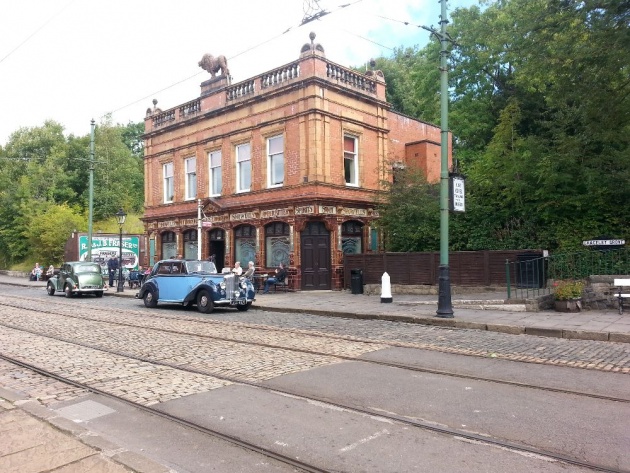
Cars from the Classic Transport Gathering outside the Red Lion pub.
Learning at the Museum
There is a learning facility in Stephenson Workshop in Town End, and educational visits can be arranged for children and young people. These can be museum led, or self led, and cover a wide range of subjects. History is, unsurprisingly, one of the subjects covered, but others include literacy, information technology, science, art and design, maths, leisure and tourism and functional skills. These are linked to the UK's National Curriculum and other curricula. Learning downloads are available from the museum's site and a resource pack for teachers is available with bookings. Learning trips need booking in advance; students cannot simply turn up and enter like a normal visitor.
The Tramway
The tramway itself is constructed from rails and overhead cables salvaged from across the country. Apart from between Wakebridge and Glory Mine, there are two sets of track for the trams to run on. There are a number of stops where the trams can be got on or off, although those in Town End are only available for one or the other.
Town End
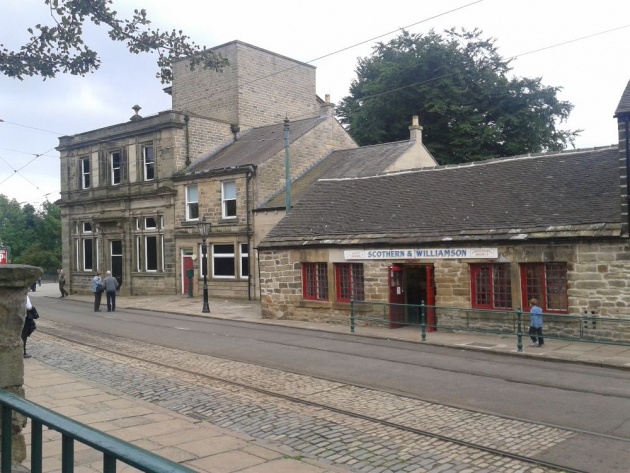
Buildings at the Town End terminus
At Town End there is the terminus of the tramway for boarding the trams and Stephenson Place for getting off them after the ride to Glory Mine and back is finished, assuming that passengers don't alight at either of the other two stops on the line.
Town End is where the majority of the buildings for the constructed period village scene are, as well as much of the street furniture, although some is also at other places along the tramway. These are shops, eating places, exhibitions and the workshop and tram depot, as well as a couple of phone boxes - including an old-style British police call box - more instantly recognisable to people as a TARDIS these days! - and other items of machinery.
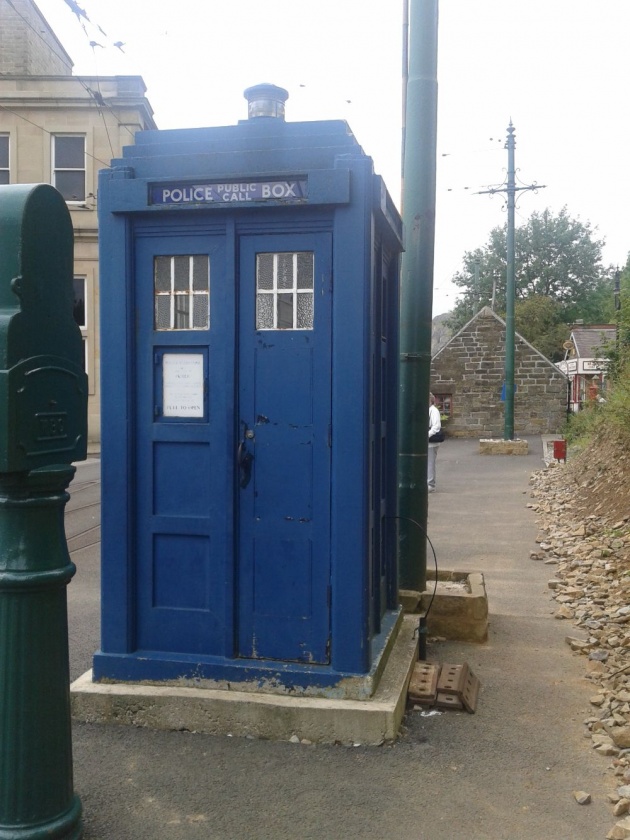
An old TARDIS-style Police Call Box
Dominating Town End is the Georgian facade of the old Derby Assembly Rooms which were dismantled after a fire and reassembled on site and which now house the Survive and Thrive exhibition, which covers the construction of modern tramway systems in Britain, and various temporary exhibitions. Just outside the Assembly Rooms is the starting point for the trams.
This building is attached to the Burnley Tramway Company offices and the Yorkshire Penny Bank, which now house the John Price Memorial Library and Archives of the National Tramway Museum and the Scothern & Williamson souvenir shop, which sells such things as tram related models and books, respectively.
Continuing on this side of the tramway there is the two story Stephenson Workshop, which was originally constructed on the site in the 1800s as a smithy and wagon works for Stephenson's mineral railway which was used to transport limestone from the quarry to the kilns in nearby Ambergate. This building has a learning facility on the ground floor, as the museum provides learning opportunities for children and young people, either run by the museum itself or directed by teachers. On the first floor of the workshop is the Stephenson Discovery Centre, which has interactive displays on tramways and the 1800s.
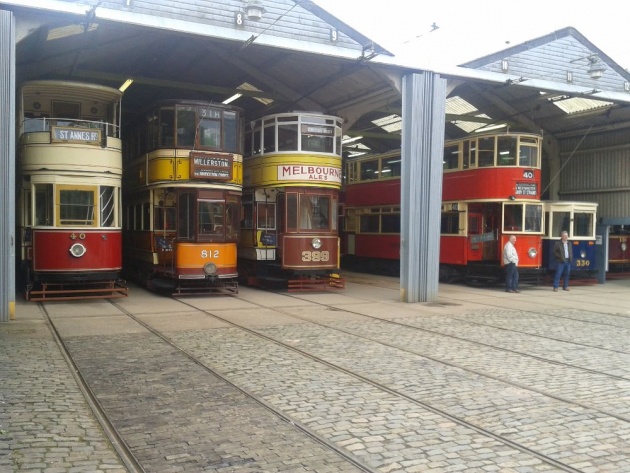
Trams in the tram depot
Stephenson Workshop connects to the workshop viewing gallery, where there are various exhibits and which overlooks the on-site workshop where the trams are maintained and new acquisitions are restored; restoring a tram can cost several hundred thousand pounds. The depot where trams not currently being used, exhibited or stored elsewhere is connected to the workshop, but can only be reached from outside, where there are tracks and mechanisms for allowing the trams to run on the tramway.
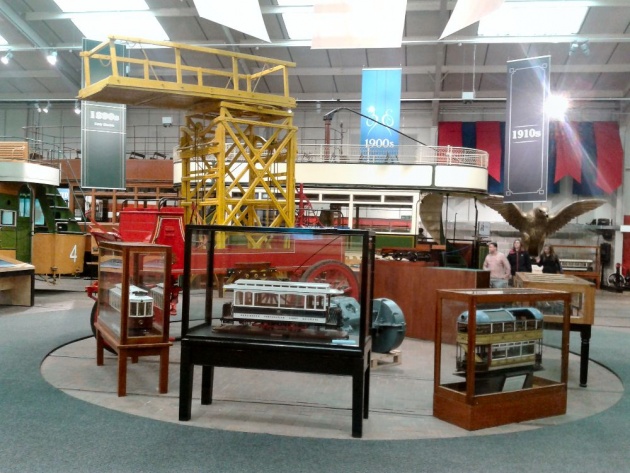
Inside the Great Exhibition Hall
Just beyond the depot is the Great Exhibition Hall. Inside this is the Century of Trams exhibition, where restored trams from the earliest horse drawn to the last electric trams of the 1960s are displayed, along with various items of period street furniture and other period items from around the country. The building also houses the Discovery Depot indoor children's play area. The hall was built for the museum, although the windows were rescued from the tram depot in Doncaster.
On the other side of the tracks are more buildings. The first of these is the Eagle Press, inside which is a collection of material related to printing.
Bluebells Ice Cream Parlour is behind the printer and sells a variety of ice cream flavours, as well as hot drinks in colder weather.
Barnett’s Sweet Shop is next up and sells old fashioned sweets from jars, as well as a number of pre-packaged and souvenir varieties.
Rita's Tea Rooms is a cafe which serves hot and cold drinks, foods, cakes and sandwiches and has an outdoor eating area.
Further up is the Red Lion pub. Originally in Stoke on Trent it was dismantled and reassembled on site. The pub serves a selection of local beers and lagers as well as hot drinks and cake, and has some outside seating. The Poulson Room is on the first floor of the Red Lion and serves pie and peas and afternoon teas for booked parties, and can also be privately hired.
Another option for food is to pre-order a picnic bag from the museum itself to eat at the various picnic areas around the site.
Beyond the buildings is the Bowes-Lyon Bridge, between Town End and Victoria Park, which used to stand in Hertfordshire at Stagenoe Park and was reassembled at the museum. The Bowes-Lyons are a Scottish noble family; the late Queen Elizabeth the Queen Mother, wife of George VI and mother of Queen Elizabeth II, was born Elizabeth Angela Marguerite Bowes-Lyon.
Victoria Park
The Victoria Park tram stop, which has two tracks and a stop on each track, provides access to the car park and main entrance. At the park are a bandstand and a play area. This is the point where visitors will enter the museum.
The London 59 Tram at Victoria Park
Wakebridge
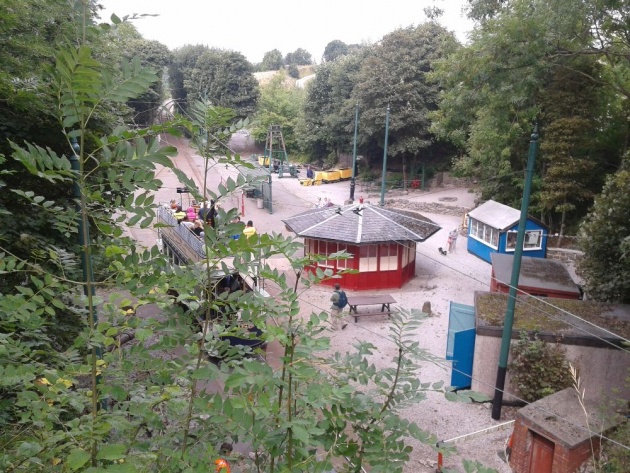
Looking down at the Wakebridge tram stop
This is a small tram stop, again with two tramlines, here, including a shelter with stained glass. Wakebridge is actually a small, often unmarked on maps, hamlet that this is fairly near.
There is a lead mining display - lead mining was an important industry in Derbyshire; for more information on lead mining, there is the Peak District Lead Mining Museum in nearby Matlock Bath - at the tram stop, operated by the Peak District Mines Historical Society at the site of Wakebridge Mine. There are a number of restored items of equipment on permanent display here.
The Woodland Walk and Sculpture Trail can be joined at Wakebridge.
Glory Mine
The terminus at the opposite end of the tramway to Town End, this simply provides access to a path which visitors can walk up to the Sherwood Foresters Memorial at Crich Memorial Stand. It currently lacks any platforms or buildings, but there is a picnic area.
Go for a Walk
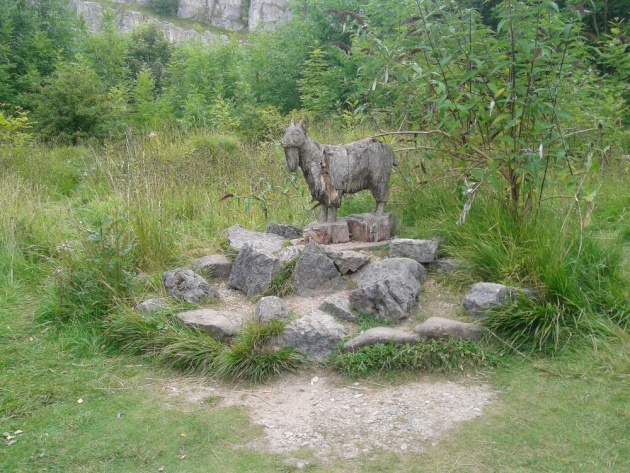
One of the sculptures on the Sculpture Trail
The Woodland Walk and Sculpture Trail winds through the area surrounding the museum, with various wooden sculptures dotting the path, carved by the museum's resident sculptor. There are picnic areas on the path, as well as a labyrinth made from stone donated by the quarry.
Picnic Areas
There are a number of picnic area throughout the museum, some looking out across the Derwent Valley.
The Museum's Trams
The first tram was purchased in 1948 and since then many more have been acquired - the museum now owns over seventy historic vehicles - from many different places. When these are first acquired, most have been neglected and some have had rather unusual uses - such as a holiday cottage! - since they stopped doing their original job. The museum picks and chooses trams to represent every era of the history of the transportation form, including from overseas.
These trams are, after acquisition, mostly, refurbished (there is one in the Great Exhibition Hall which is displayed as it was found), work which is done on site in the museum's own workshop. Some trams are usually in the workshop undergoing work, whether this is restoration or simple maintenance. Some run on the tramline on the site, being stored in the depot next to the workshop when they are not in active use, others are placed on display and some are loaned out to other museums across the country.
Trams run on the tracks whilst the museum is open, with power provided by overhead cables, and different trams from the museum's active fleet are rotated through service on different days. Open top trams, of which there are both single and double decker models, generally run only in better weather. The number of trams running daily does vary, with three trams operating at the peak of the season but two or perhaps only one at other times. once entrance to the museum has been paid, it costs nothing to use the electric trams themselves, although there is an additional charge if the horse drawn tram is used, which is typically on a special event day once a year.
Visitors will be given one old penny in pre-decimal British currency. These are exchanged for a tram ticket upon getting on a tram, with the conductors using the original machines that were used on the tramways themselves, the machines part of the museum's extensive collection of tram-related and period material. The ticket can be used all day once purchased, so don't worry that you no longer have the penny!
Accessibility
The trams at the museum were built before such things as accessibility to wheelchair users was a matter of priority - or probably even considered. As a result, there is only one tram, the Berlin 3006, that is wheelchair accessible. This may be requested on arrival for those with a wheelchair, and will run from 11:30 am to 2:30 pm on request. It is not suitable for mobility scooters and does have a weight limit of 300kg.
The site itself has, however, been constructed with the accessible needs user in mind. There are disabled toilets in several places, ramps or lifts in the buildings and wheelchairs available to hire for a refundable £10 deposit, which can be booked in advance.
The Museum's Collections
The museum doesn't just have the trams, building and street furniture which can be seen in the village scene and exhibitions in their collection. Some such as ticket machinery are also used, but large parts of the collection are not on regular display.
The Burnley Tramway Company offices in Town End contain the John Price Memorial Library, which has a collection of pamphlets, reports, books and Acts of Parliament, as well as maps, technical drawings, guides and ephemera such as timetables, tickets and press cuttings. These cover the history of tramways and other light railways in Europe and North America, as well as in Britain. In addition, the museum has an extensive collection of photographs. These archives are used by scholars and historians, as well as by students, but it is necessary to make an appointment in advance in order to view them; ordinary visitors to the museum cannot simply enter the archives and have a look through them.
There is a recently updated online catalogue of the collections that the museum holds as well as online exhibitions assembled by volunteers.
Crich Memorial Stand, Overlooking the Museum
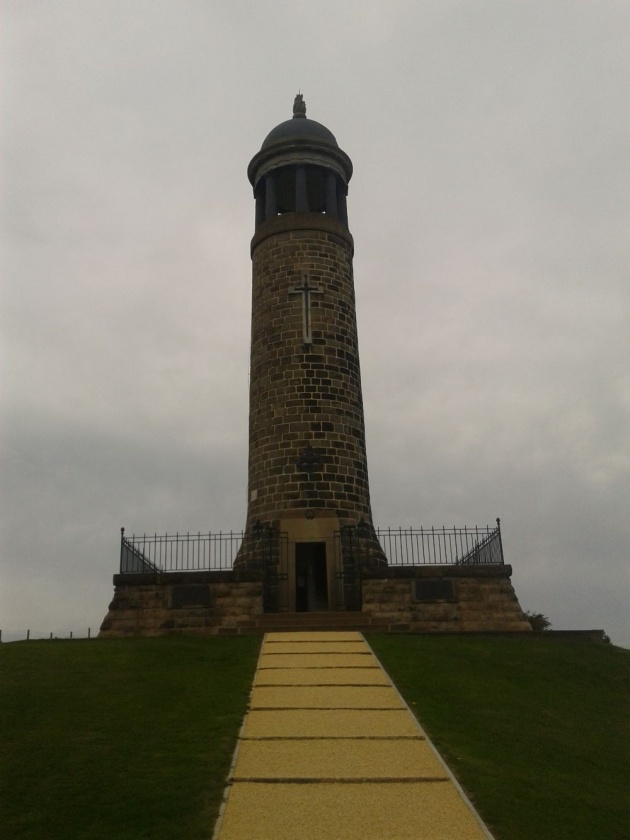
The Sherwood Foresters Memorial at Crich Memorial Stand
This is not actually within the museum grounds itself, but from the top of the memorial you can see across the entire village. It can be reached from the village from the Glory Mine terminus on the tramway. The stand hosts the Sherwood Foresters World War Memorial, as well as parking and a beacon.
The Museum is Dog Friendly
Crich Tramway Village is dog friendly, as long as they are on a lead and their owners clean up after them, and dogs are allowed in the majority of the buildings, except inside Rita's Tearooms and the indoor children's play area, and on the trams themselves. Whether or not they will enjoy riding on the trams is a different matter!
Tram Driving Experience
One of the more unusual gifts you can buy is the Tram Driving Experience. There are several packages available, including one for more advanced students, the Ultimate Driving Experience, and the recipient can learn how to drive the trams during a full day on the site. Be warned; these experiences are not cheap!
Volunteering for the Museum
As with many historical museums, the National Tramway Museum is always interested in volunteers. Volunteers can work in a wide range of jobs, not just maintaining and running the trams and tracks, but also administration, retail, catering and guides.
Riding a Tram from Town End to the End of the Line
All images copyright eGDC Ltd



